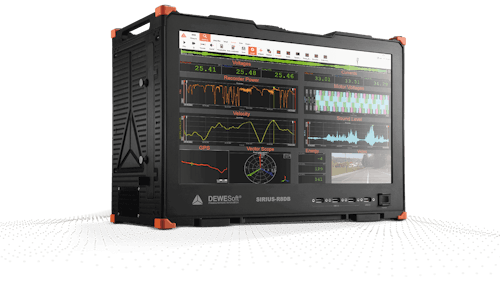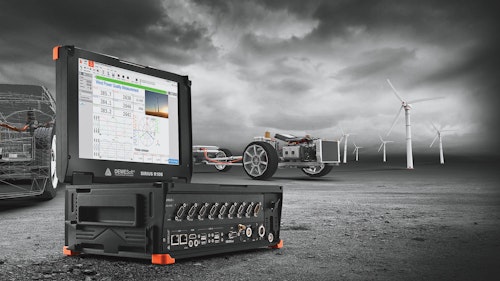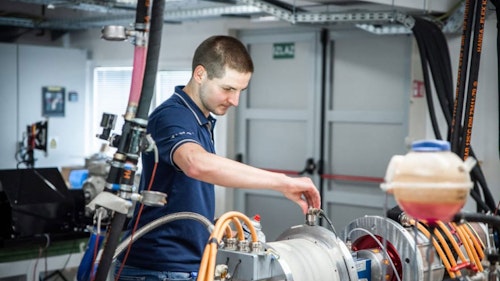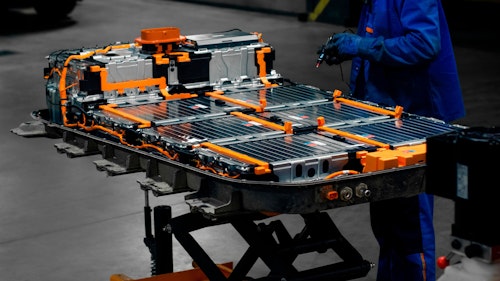SIRIUS® XHS 4xHV, 4xLV
3-Phase Power Analyzer
Dewesoft provides precise solutions for aircraft electrical power testing — from individual components like actuators and propulsion systems to full aircraft microgrids. Our systems measure performance, power quality, frequency spectra, and high-speed transients, while ensuring compliance with certification standards through ready-to-use reports.
As a one-stop provider of sensors, hardware, and software with built-in data validation, we make testing straightforward and reliable.
With advanced tools for motor efficiency mapping, torque measurement, thermal, vibration, acoustic, and structural analysis, Dewesoft offers a scalable, turnkey solution. All measurements are seamlessly integrated into a single powerful software platform, giving you complete multi-physics insight in one place.
DewesoftX software verifies aircraft electrical power conformance, visualizes and characterizes all signals in report-ready displays in frequency and time domain, to create the appropriate report. Supported standerds include MIL-STD-704F, GJB181x-xxxx, GJB 5558-2006, ISO 12384:2010, ISO 1540:2006.
Our amplifiers offer electrically safe inputs of ±2000 V, CAT II 1000 V, and CAT III 600 V according to ISO 61010. The "worry-free" solution provides isolation for all inputs and sensors: channel-to-ground, channel-to-channel, and even isolated sensor excitation. Experience less noise, no ground loops, and the superior signal quality you can rely on.
Precisely measure DC voltage (28 V DC, 270 V or even 800 V DC), AC voltage (115 or 230 or 400 V AC) with 400 Hz or variable frequency (360…800 Hz) and calculate power towards 0.03% accuracy. Acquire electrical transients during system startup or load shedding.
The system instantly analyzes over 100 power parameters, including P, Q, S, PF, and cos phi in static or highly dynamic use cases. Visualize the outcome in y-t, oscilloscope, FFT waterfall for harmonics analysis, vector scope, and many more. Full analysis can be performed online or in post-processing modes. Dewesoft system combines the functionality of traditional power meters, power quality meters, oscilloscopes, and transient recorders into a single instrument.
Choose betwren high precision zero-flux electrical current transducers (DC-CT) with maximum dynamic range, bandwith and precision, AC/DC current clamps, Rogowsky coils, or shunts. Most sensors can be directly powered by our power analyzers.
DewesoftX efficiency analysis helps to optimize electric input vs. electrical output, vs. mechanical output power. Motor efficiency analysis settings are consolidated in the Motor Analysis module, using advanced techniques like Clarke and Park transformations, efficiency and loss mapping.
Extend your setup and measure high-precision torque and rotational speed (incremental encoders, sin/cos resolvers), temperature (RTD, TC, IR camera), acceleration / vibration, noise / microphone, avionics bus integration, or video (standard, high-speed), or add our battery testing solutions - all fully time synchronized.
Dewesoft power analyzers offer plug-and-play capabilities with the award-winning DewesoftX software. Simply select the input signals and the compliance standard, and the aircraft electric power analyzer module will handle the rest. Use pre-defined visualizations or individually configure your user interface on multiple screens. Replay test results any time including camera (video, IR).
Acquire and store all input and calculated signals in raw data format with up to 15 MS/s per channel. This delivers outstanding flexibility, ensures data integrity and allows a more detailed data analysis and comparison in post processing, correlating with simulation or ML/AI models.
Dewesoft power analyzer hardware includes high-speed amplifiers that offer sampling rates of up to 15 MS/s per channel. These amplifiers use SAR analog-to-digital converters with built-in hardware filtering capabilities.
SIRUS® XHS power analyzers offer 5 MHz bandwidth acquisition and analysis with up to 15 MS/s sampling rate per channel.
A single power analyzer instrument can host up to 64 channels in a single chassis. For higher channel counts or full-scale electrical microgrid applications including generators, power electronics (DC-DC, AC-DC, DC-AC), actuators and other devices, devices can be scaled up fully time-synchronized.
Our power analyzers can be modular or configured as all-in-one devices with built-in display, battery, storage, and CPU. This makes them perfect for in-field power quality measurements for quick fault analysis or regular maintenance, repair and overhaul (MRO) inspection routines. The instruments can also run on a user provided 9-36V for ultimate flexibility.
Every Dewesoft data acquisition system is bundled with award-winning DewesoftX data acquisition software. The software is easy to use but very rich and deep in functionality. All software updates are free forever with no hidden licensing or yearly maintenance fees.
Enjoy our industry-leading 7-year warranty. Our data acquisition systems are made in Europe, utilizing only the highest build quality standards. We offer free and customer-focused technical support. Your investment into the Dewesoft solutions is protected for years ahead.
And we're confident you'll love it too! But don't just take our word for it. Get hands-on with a demo unit, completely free of charge. No strings attached, just real data. Reach out to your local Dewesoft team and get your demo unit now!
It includes everything you need for advanced data acquisition and common signal processing — no maintenance fees, no contracts. You buy it, you own it. All future updates? Free forever. And the best part? Analysis seats are unlimited and free. Once the data is recorded, anyone can download our software to review and analyze your data — no license needed.
Dewesoft is 100% owned by employees who believe in what we do — and love doing it. We’re in this with heart, passion, and long-term commitment. What does that mean for you? Our core value — caring for our customers — isn’t going anywhere. We’re here for the next 100 years, protected from outside acquisitions. Your investment in our technology is safe, supported, and future-proof.
At Dewesoft, quality isn't just a promise — it's a core value. Our products are 100% designed, developed, and manufactured in-house, right in the heart of the European Union. From precision machining and PCB manufacturing to final assembly and software development — we do it all ourselves, to the highest ISO standards. We're proud to support local production and take social responsibility seriously.
At Dewesoft, quality is more than just a word — it's a commitment. That's why our products come with an industry-leading 7-year warranty. It's just one more way we protect your investment and give you peace of mind for the long run.
The aviation industry is undergoing a profound transformation. Aircraft electrification is no longer a vision - it’s reality. From replacing hydraulic and pneumatic by electrical actuators, electric taxiing or advanced fully electric propulsion, the future of flight depends on designing systems that are safe and reliable, sustainable (reduced CO2, noise), efficient, and lightweight.
At the heart of this change lies one challenge: testing and validating aircraft power systems with accuracy, speed, and confidence.
The true challenges in aircraft electrical power testing
Weight vs. efficiency: Every additional weight matters. Aircraft electrical components - generators, electronics, batteries, and motors - must deliver maximum efficiency and power density at minimum weight.
Reliability under all conditions: Systems must operate flawlessly across extreme weather, altitudes, lighting strikes, and mission profiles. Failures are not an option.
Energy conversion & power quality: From steady-state operation to sudden transients, every watt matters. Test engineers must evaluate conversion efficiency while ensuring compliance with stringent aircraft power quality standards.
Scalable testing: From component to full-scale aircraft electrical microgrid, requires deep dive R&D lab based testing, simulating elements where necessary, looking at operation and fault investigation, accelerating and minimizing a safe in-flight testing program.
Flexible testing requirements: Modern aircraft demand flexible test setups with data acquisition and power analysers for continuous long-term high-speed sampling of entire simulated flight profiles, analysing harmonics, disturbances, and transients.
Aircraft Electric Power analysis has become more critical than ever:
Already high complexity in classic aircrafts, with engine-driven generators, Auxiliary Power Unit (APU), power converters, electric galleys, DC network, primary and secondary flight control systems (ailerons, elevator, rudder, flaps and spoilers), to passenger comfort systems.
Many electrical protection and safety systems, such as emergency power supplies, circuit breakers, and de-icing systems.
Transition towards electric actuators reducing weight, improving efficiency, and enhance maintainability, for various operations (e.g., flight controls, landing gear, folded wing tips, etc.).
Electric taxiing reducing cost, CO2, and noise on ground level.
Hybrid-Electric and turbo-electric propulsion on the rise.
Liquid hydrogen (LH2) tanks and Fuel Cells (FC) as power source.
Pure Electric Aircraft (EA) - Advance Air Mobility (AAM), Vertical Take-Off and Landing (eVTOL), Urban Air Mobility (UAM) or Air Taxis (AT), with full electric propulsion, high number of electric motors, and high-performance traction batteries.
Electrical power systems with >800 V DC and 400 V / 400 Hz AC microgrid, reducing weight.
Rise of electric Unmanned Aerial Systems (UAS) and drones (eVTOLs).
Global leaders trust Dewesoft for advanced and precise dynamic and static electrical power analysis in the aircraft industry. Our solutions are used to test single components, complex electric propulsion, complete electric setups (all copper) including the aircraft’s microgrid power quality. These tests ensure reliability, performance, efficiency, safety, resilience, and compliance to standards - critical for successful type certification.
Dewesoft is more than just a DAQ product provider. We are a trusted partner in engineering and testing and we collaborate with aviation customers for the future of aviation. Here is what you get by working with us:
Trusted by leading aircraft manufacturers and research institutions.
Conformance check (frequency and time domain, harmonic order limits, distortion requirements), ready to analyse abnormal states (power failure, load shedding, etc.), testing under environmental stress.
Easy to integrate in test beds (Copper Bird, Iron Bird, Power-Hardware-in-the-Loop - PHIL).
Unique eco system covering Electric Power and Power Quality, and multi-physics with a single software, covering multiple attributes.
Proven reliability in mission-critical applications.
Tailored support from consultancy, concept to certification.
Used in Maintenance, Repair and Overhaul (MRO) ensuring operational reliability.
Industry-leading 7-year warranty.
We offer free trial of our hardware and software. Contact us and arrange your demo unit(s) today and try the solution before you decide to buy it.
The classic aircraft electric setup and microgrid grid builds up on power generation, power conversion (AC/DC, DC/DC, DC/AC), power distribution and devices (actuators, electronics, avionics), and electric propulsion comes in.
DC nominal voltage of 28 V (standard), 270 V or up to 800 V (EV).
AC nominal voltage of 115 V, 230 V or 400 V (line-to-neutral) with 400 or 800 Hz nominal or even Variable Frequency AC (VFAC): 360–800 Hz.
Normal operation, abnormal operation, emergency, starting, transfer, power failure.
Challenges are abnormal, transients, and fault conditions. looking at inrush currents, voltage sags/dips, interruption, switching transients, abnormal frequency/voltage.
Harmonic analysis, THD, orders of harmonics (up to 100 orders, 5 MHz), spectrum range.
AC voltage as RMS, phase to neutral value for each half cycle.
Steady state AC voltage.
Voltage unbalance, voltage modulation amplitude, voltage phase difference.
Steady state DC voltage and current.
DC Voltage distortion factor and ripple amplitude.
DC current distortion factor and modulation amplitude.
Dewesoft offers testing methods and data in compliance with the following standards:
MIL-STD-704F: addressing different systems, technologies, aircraft classes, and power groups (SAC, TAC, SVF, TVF, SXF, HDC, LDC).
ISO 12384:2010: standardizes the performance characteristics of aircraft electrical power.
ISO 1540:2006 how pressure regulators must be designed, tested, and perform.
RTCA DO-160E, Section 16: voltage/current distortion, harmonic orders.
GJB 181x-xxxx aircraft power supply characteristics.
GJB 5558-2006 how to test and verify the behavior of aircraft electric power systems.
GJB 572a-2006 aircraft external power supply characteristics and general requirements.
GJB 5189-2003 aircraft power supply characteristic parameter test method.
Dewesoft is the right choice for full electric propulsion testing, and specifically electric motor and battery testing. Our high-precision, all-in-one data acquisition solutions deliver accurate efficiency, power, and dynamic performance measurements, paired with isolated multi-physics inputs. This is perfectly tailored for R&D lab and in-flight testing, ensuring engineers gain deeper insights, faster, with absolute confidence.
Fully electrified propulsion systems have numerous configurations, but basically consist of:
Energy storage system (here battery, Fuel Cell + battery)
PDU (power distribution unit)
PCU (propulsion control units / inverter / power electronics / motor control)
Electric motors / engines with propellers (for example open rotor type)
Users need a scalable measurement and testing solution for electric power analysis of 3- or 6-phase high-power AC motors, driven by a wide range of Pulse Width Modulated (PWM) frequency signals up to 100kHz including vector-control parameters.
Permanent Magnet Synchronous Motors (PMSMs) are the dominant choice for electric aircraft due to their high efficiency (~95–98%) and power density. Most aircraft PMSMs use 3-phase designs (standard for high-power applications), because of its simplicity & maturity. It is well-understood and compatible with standard inverters.
Some advanced or fault-tolerant systems use 6-phase for redundancy and fault tolerance - e.g. NASA X-57 Maxwell with 60 kW per PMSM in a distributed propulsion system.
Typical Datasheet of a PMSM:
Power Output: 200 kW … 2 MW, 650 kW (continuous)
Voltage: 300 V … 800 V DC
Efficiency: 95–98%
Power Density: 5–10 kW/kg (~8 kW/kg in Magni650)
Cooling: Liquid-cooled (air-cooled for small UAVs)
Poles: 8–16 poles (high pole count for compact design)
Phase Configuration: 3-phase (6-phase for redundancy)
Torque Density: 15–25 Nm/kg, ~20 Nm/kg
Max RPM: 2,000–3,500 RPM (often geared) | 2,500 RPM
DewesoftX, our award-winning data acquisition software, is the complete solution for electrical power testing. With dedicated modules it delivers everything you need for accurate and successful testing:
What do we offer:
Standards compliance coverage supporting MIL-STD 704F, ISO 12384:2010, ISO 1540:2006, GJB181x-xxxx, GJB 5558-2006 - this is what certification bodies like FAA or EASA expects to instantly look at.
Highly dynamic and flexible electrical power calculation and analysis of electric motors (3 and 6 phases; 400 Hz, 800 Hz, 300….800 Hz VFAC).
Visualize AC waveform distortions and harmonics, together with selectable standardized graphical reference curves including alarm triggers.
Visualize time-based signals, together with selectable standardized graphical reference curves including alarm triggers, accelerates reporting.
Full flight profile recording of raw and calculated power and standardizes signals, in parallel to triggered events.
Transient detection, identifying power interruptions, voltage sags, or frequency deviations during testing.
Power quality, looking at flicker, interharmonic, and harmonics, Total Harmonic Distortion (THD) for voltage and current, torque ripple / cogging torque.
AC and DC power analysis.
Scale to work with thousands of signals, multiple screens, high data and storage throughput.
Reading avionics busses (ARINC 429, ARINC 664/AFDX, CAN, MIL-STD-1553, others).
Video camera support (standard, high-speed, infrared / IR).
Support of GNSS/IMU (position, time, speed, kinematics).
Able to run with different configurations - single master / multi clients or even multi master and multi clients.
High data throughput, online validation and storage.
Support of telemetry for Flight Test Instrumentation (FTI).
And many more features upon your request.
DewesoftX is the right choice for aircraft electric power as it unifies powerful visualization of electric power, time and frequency domain data analysis compliant to aerospace standards, long-duration data recording, delivering the flexibility engineers need to validate efficiency, reliability, and other relevant attributes.
Main benefits of Dewesoft power analyzers and data acquisition systems:
Scaling up to hundreds of channels testing full-scale electrical setups.
Highly accurate voltage and current measurement with low signal distortion and high phase accuracy, paired with electrically safe and isolated design (ISO 61010), low temperature drift → traceable results, naming measurement uncertainty (PTB, NIST).
Direct voltage inputs from mV to 2000 V.
Full measurement chain including own highly-precise current transducers (CT), covering DC to high‑frequency electrical currents + sensor supply, alternatively (3rd party CTs, clamps, Rogowski, shunt).
High quality frequency based power analysis (0.03%) that can scale from single motor to all elements in micro grid (P, Q, S, PF, cos phi, distortion, harmonic distortion, reactive power of harmonics for each phase and total.
High-speed 15 MS/s/channel and 5 MHz bandwidth, covering accurate power calculation, wide-range harmonics analysis (64th order), and acquisition of transients (glitches, extreme switching, fault transients, or short circuits).
Support of multi-physics inputs with DC power, rotational speed, torque, temperature (stator, rotor), vibration, noise / acoustics, flow, force, strain, displacement, pressure - supporting TEDS.
Super counter for high speed torque and rotational speed sensing.
Various time synchronization options: Ethernet PTPv2 (IEEE1588:2008), GNSS, IRIG, optical Ethernet links.
Open and easy to integrate into your system integrator of choice: EtherCAT, Ethernet / openDAQ, CAN FD, OPC UA, MQTT, etc.
Robust and portable instrument for Flight Test Instrumentation (FTI).
Dewesoft SIRIUS and SIRIUS XHS power analyzers are reliable DAQ solutions that covers the modern multi-physics testing approach, delivering electric power, efficiency, thermal integrity, vibration, acoustics, structural durability, software functionality, safety, that reduces testing time and cost.
Learn more about our power analyzers.
Dewesoft DC-CT® current transducers provide the advantages of a zero-flux current transducer but with lower power consumption and a more compact design. With a broad measurement range, high bandwidth, excellent linearity, high accuracy, and minimal temperature drift, the DC-CT® stands out as one of the top current sensors available in the market today.
Variable ranges: 50 … 2000 A
High accuracy
Ready to analyse power input to avionics, including idle measurement (ppm level)
Wide and flat bandwidth (500 kHz)
Minimum Temperature drift
Minimum phase shift
CAT II 1000V and CAT III 600 V
Compact power supply for current sensors: SIRIUSi-HD-PWR-MCTS2
Alternative: support of 3rd party sensors (zero flux, shunt, Rogowski coil)
We've gathered all the answers you're looking for, neatly organized just for you.
Our software supports many major aerospace and power standards — e.g. MIL-STD-704F, ISO 12384:2010, ISO 1540:2006, GJB-181x-xxxx, GJB-5558-2006, RTCA DO-160E Section 16. Dewesoft X is also constantly improving regarding reporting which helps you to comply with FAA / EASA requirements directly. Together with you we can work on ready-to-use report templates.
Our hardware offers high-speed sampling (up to 15 MS/s per channel) with bandwidths up to 5 MHz, ensuring you can capture fast transients and high-order harmonics. We also support detection of interruptions, sags, frequency deviations, with excellent isolation to avoid noise and ground loops.
Yes — the system architecture is scalable. You can start with a single 3-phase power analyzer setup for component- or subsystem-level testing, and expand (channels, multi-physics sensing), electric propulsion system with multiple electric machines, to full aircraft microgrids and large-scale test beds. All instruments are time-synchronised and modular (hardware + software) to support that growth.
With your Dewesoft system you get: the hardware, the award-winning DewesoftX software (free updates forever, no maintenance fees), access to support (including global network), a 7-year warranty, and optional training. We also offer free trial/demo units so you can test hands-on before committing.
All input channels are electrically isolated (channel-to-channel, channel-to-ground), with certified safe input limits like CAT II 1000 V, CAT III 600 V, etc. Amplifiers and sensors are designed to minimize crosstalk, noise, and ground loop errors. The system works reliably in environmental stress, and is rugged enough for field, often for in-flight or MRO (maintenance) use.
LDC 28V DC, HDC 270V DC, SAC 115V AC 400Hz Single-Phase, TAC 115V AC 400Hz Three-Phase, SVF/TVF Variable Frequency AC.
The software is not replacing an official certification, but is a solid base for pre-qualification.
Yes, it is compliant to the most recent revision as it is often a mandatory requirement.
The MIL-STD-704 only addresses power quality. The named standards focus mainly on device specs for permanent installations in aircraft and are not in scope here.
Yes, these are the most stressful steady-state conditions defined in the standard.
Transfer operations involve a momentary power interruption (e.g., 50ms for 28V DC Category B). Customers need to know if the module can "ride-through" this interruption without resetting.
The software can analyze ripple and distortion.
Can't find the answer you're looking for? Our team is happy to answer your questions.
See and browse related and compatible data acquisition products.
3-Phase Power Analyzer
Portable Power Analyzers
1-phase power analyzer with integrated DC-CT® current transducer
New generation high-channel distributable data acquisition system
The best AC⚡DC current sensor available today!
High-Accuracy Sensors for Current Measurement
Modular Industrial Data Acquisition (DAQ) Systems
EtherCAT Data Acquisition and Real-Time Control System
Data logger and embedded data acquisition system
Award-Winning Data Acquisition and Digital Signal Processing Software
See and browse related and compatible testing solutions.

High-precision electrical power measurement and analysis [AC⚡DC]

High-precision power quality measurement and analysis

Power and efficiency testing of electric motor and inverter

High-precision measurement and data analysis